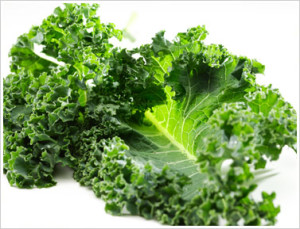I was first introduced to kale in nutrition school. It was the newest healthy food “fad”, known only to an inner circle of aspiring health conscious professionals. Today, kale has become the “king” of all health foods, as common as lettuce in some circles. If you aren’t yet eating it, chances are that you know at least one person who is. It’s not eight degrees of separation, but one degree of separation when it comes to this power veggie.
Kale is thought to have originated in Asia Minor, brought to Europe in 600 BC, and brought to the United States by English settlers in the 1600s. Both the ancient Greeks and Romans were known to have grown kale.
So, what is it that has so many people on the kale bandwagon?
Kale is a dark, green leafy vegetable that is a member of the cruciferous, or cabbage family. Other greens of the cabbage family include mustard greens, turnip greens, kohlrabi, watercress, and collard greens. There are several varieties of kale, known ornamental kale, dinosaur (Lacinato) kale, and curly kale. Curly kale is most widely found in your local market. Look for leaves that are crisp and green. Often the smaller, younger heads of kale are a little less bitter in taste.
Dark green leafy veggies like kale have two times more nutrients than any other green food and five times more nutrients than fruit. That ranks kale among the most highly nutritious vegetables. Generally speaking, greens are loaded with fiber, folic acid and chlorophyll. They are high in calcium, a great alternative for those of us not drinking dairy. They contain magnesium, iron, potassium, phosphorous, zinc and vitamins A, C, E and K (good for the eyes) and more. Greens are so essential to good health. In fact, if you do just one thing for your diet, this could be it. Adding in greens like kale will improve your family’s health ten-fold.
Kale, in particular, is an excellent source of vitamin A, C, B6 and manganese. It is a great source of dietary fiber, vitamins, and minerals, including B1, B2, E, iron and calcium. As a member of the cabbage family, kale is especially beneficial for stomach conditions such as ulcers, is anti-cancerous, eases lung congestion, and has detoxifying properties. Kale is also a great immunity booster and mood enhancer.
Kale is a hardy cold weather green. It’s growing season is in the fall, winter and early spring. Kale can be stored in the refrigerator in the crisper drawer wrapped in a damp paper towel or plastic bag. Make sure to wash your kale before preparing it to remove sand or dirt remaining in the leaves. The stem can be removed for salads, smoothies and kale chips by simply pulling on the leaves.
Kale can be eaten raw or cooked. Add it to soups or stews or salads. Make a Kale and Avocado Salad. Steam it for five minutes and add to homemade pizza. repare it in an omelette. Make it into Kale Chips. Or, add it to smoothies or fresh vegetable juices.
Overcooking kale will reduce its nutritional value, so plan to prepare it al dente, or cooked just long enough. It also doesn’t hold up well to boiling or sauteeing. And, unfortunately, it doesn’t freeze well either.
Kale does contain goitrogens and oxalate, which might be of a concern for some people, in particular those with a thyroid condition. Rather than eating daily, it is best rotated with your other favorite greens.




